How to Boost Your PRITE or Psychiatry Board Exam Score

This article covers two easy strategies to help increase your score for the Psychiatry Resident-In-Training Examination® (PRITE®) and increase your likelihood of passing the American Board of Psychiatry and Neurology (ABPN) Psychiatry Board Exam. These two techniques are useful, easy to implement, and only require a little of your time.
The first strategy is to identify what you don‘t know. Sounds easy, right? The key is to go through a curriculum and identify what you don’t know—not what you are weak at—but what you don’t know. The second strategy is to take advantage of human error. Tests are written by humans, and humans make errors. By paying attention to five types of flaws that question writers make, you can narrow down an answer choice to either the correct answer or a 50/50 probability, even if you don’t know anything about the topic. By combining these two strategies, you’ll be able to increase your PRITE® or ABPN Psychiatry Board Exam score and increase the likelihood of passing the exam. Let’s get started.
Strategy 1: Determining your unknown unknowns
As you begin to study for a psychiatry exam, you’ll find that there are areas you are comfortable with. Maybe you have a special interest in depressive disorders and feel confident with any question that might be asked on premenstrual dysphoric disorder. Therefore, you spend less time reviewing them. This is one of your known knowns—you know that you know the information. There is little utility in spending too much time on your known knowns when preparing for your exam.
During my PGY-1 year, my understanding of catatonia was poor. Catatonia was just a term to me. I had a poor grasp of the heterogeneity of presentation and different subtypes, did not understand the proper use of the Bush-Francis Catatonia Rating Scale, and had no experience doing a lorazepam challenge (with the lack of observing any clear prior cases.) Catatonia was a known unknown. Because I recognized this specific deficiency, I was able to target my learning on when to have a higher index of suspicion for and conducting a proper assessment of catatonia.
Once I started to focus my learning, I came across many concepts and ideas that I knew nothing about…never even heard about some of them. These were the unknown unknowns, a concept created by psychologists Joseph Luft and Harrington Ingham. It is part of their “Johari window,” a tool that helps users identify blind spots about themselves and others.
Known unknowns are things you’re aware that you don’t know—you can recognize that you don’t understand them. Unknown unknowns, however, are unexpected because you don’t know they exist.
The way to supercharge your PRITE® or ABPN Psychiatry Board Exam score is to identify your unknown unknowns. It takes a little effort, but it is rather easy. All you need are two things:

The system works like this:
Step 1: Answer a question from a question bank. If you get the answer wrong, read the explanation. Then write down in your notebook the part of the explanation that describes why the correct answer is correct. This process helps to identify your unknown unknowns. Subsequently, if there is any other information that you did not know or somewhat knew, record it in your notebook under the same topic.
You should do this for every question you get incorrect. I also encourage it for questions you may have answered correctly but discovered new information in the explanation that you previously did not know.
Step 2: Start each study session by reviewing your notebook that contains your unknown unknowns. As you do more questions, you’ll incorrectly answer ones on topics already recorded in your notebook. For example, if you answer a question incorrectly on bupropion treatment, you’ll record in your notebook something like “bupropion: contraindications for patients with seizure disorder or those who are abruptly stopping alcohol, benzodiazepines, or barbiturates.” If two weeks later you can’t name the relevant contraindications for bupropion treatment, then you should go back through your notebook to find your first entry on bupropion and add the contraindications for anorexia and bulimia as well. While we’re on the topic, here’s a cheat sheet for bupropion.
After a month or two of recording your incorrect answer explanations, you will have a filled notebook of your unknown unknowns and maybe many of your known unknowns. If you do this on a consistent basis and get through 1,000 to 2,000 question bank questions for a 300-question standardized exam, you’ll identify most of your blind spots that questions can ask about. You will convert your unknown unknowns to known knowns.
Here’s an example of what your notebook might look like:
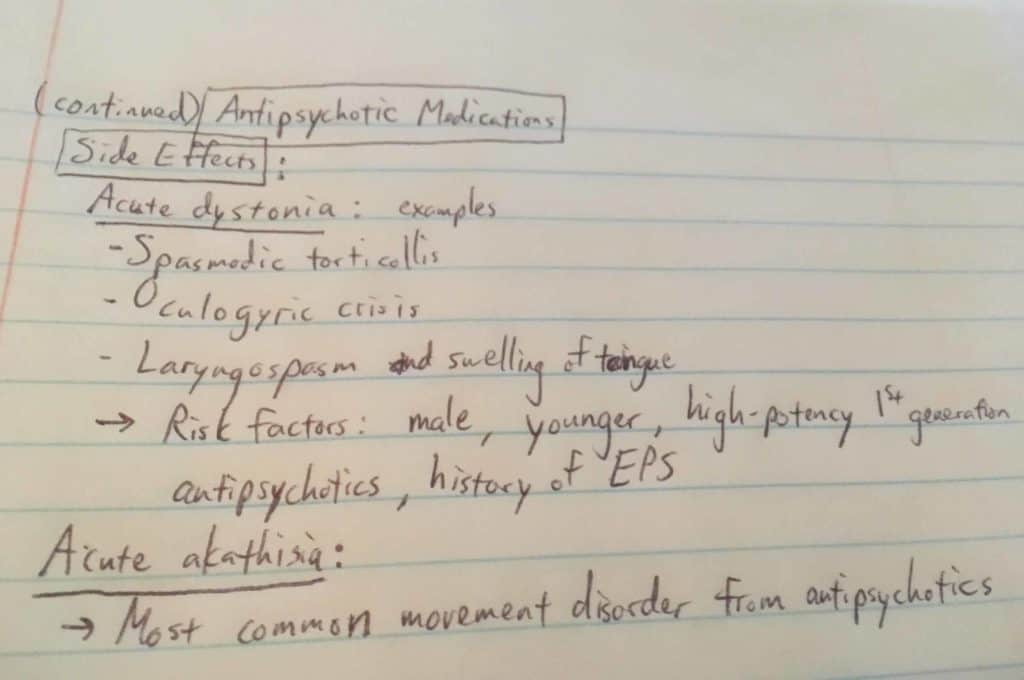
I use the same system and process to prepare for all standardized exams.
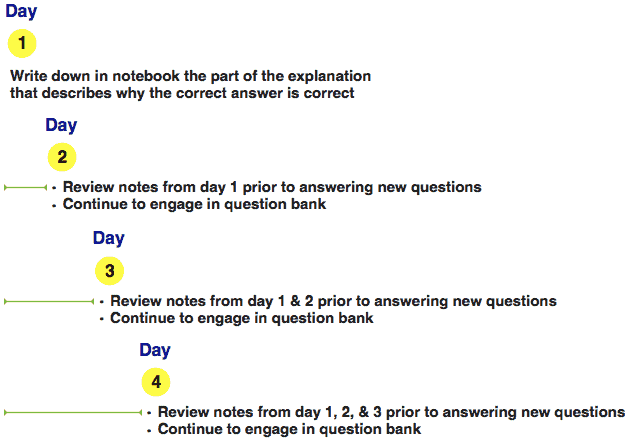
With the PRITE® or ABPN Psychiatry Board Exam around the corner, now is the perfect time to begin this system. It leaves time for adjustment and plenty of time to accumulate your unknown unknowns.
Strategy 2: Taking advantage of human error
Earlier in this post, I mentioned you’ll need two things to supercharge your standardized exam score: a notebook and time. The notebook you can buy anytime. However, time disappears.
Taking the time to identify your unknown unknowns will prepare you for the exam. However, we know five ways you can improve your score simply by showing up to your exam. You can use the errors made by question writers to boost your score.
The Anatomy of a Question
First, let’s understand the anatomy of a question.
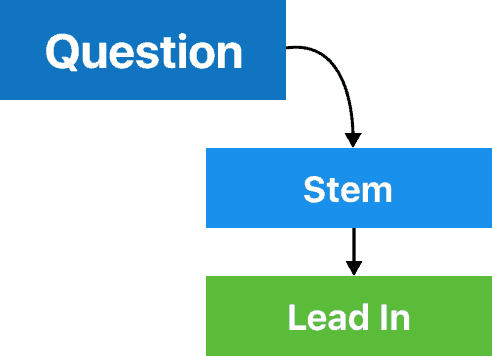
Question
A 25-year-old man is brought to the student health clinic by several concerned roommates. His friends explain that he used to be outgoing and achieve excellent grades, but over the past three months, he has stopped wanting to socialize with others and has not been attending class. In the clinic, he appears disheveled and states that he last showered about a week ago. He makes poor eye contact and does not change his facial expression as he talks. He explains that as he walks down the street, strangers around him are able to directly read his thoughts. Which of the following is the most likely diagnosis?
A question is made up of the stem and the lead-in. The stem contains the details of the question such as the clinical presentation, past medical history, and laboratory results. But, the critical part of the question is the lead-in. The question writer uses the lead-in to find out what you know or don’t know about the topic in the stem. But it is also where question writers make errors. By applying basic grammatical analysis, you will be able to identify the correct answer or at least narrow down the answer choices without knowing anything about the topic. Here are our first two tips:
1. Pay attention to grammatical cues.
Grammatical cues: one or more answer choices (distractors) don’t follow grammatically from the lead-in.
A 30-year-old woman with schizophrenia visits her psychiatrist for ongoing medication management. She has been taking risperidone for three years to help with her symptoms. This drug treats schizophrenia through which of the following mechanisms?
A. Blockade of dopamine D2 and serotonin 5-HT2A receptors
B. Dopamine D2 receptor
C. Inhibition of dopamine and norepinephrine reuptake
D. Mesolimbic pathway
B and D do not follow grammatically from the lead-in. A good test taker can eliminate these.
2. Focus on logical cues.
Logical cues: one or more answer choices don’t logically fit in with the other choices.
Which of the following has been the most clearly implicated in the etiology of intermittent explosive disorder?
A. Elevated serotonergic activity
B. Head trauma
C. Outbursts of anger
D. Prefrontal cortex dysfunction
Outbursts of anger is a sign of intermittent explosive disorder, not part of its etiology, and can be eliminated by a good test taker.
Let’s now focus on answer choices to identify a few more areas where we can gain an edge.
The Anatomy of Answer Choices
Question: A 25-year-old man is brought to the student health clinic by several concerned roommates. His friends explain that he used to be outgoing and make excellent grades, but over the past three months, he has stopped wanting to socialize with others and has not been attending class. In the clinic, he appears disheveled and states that he last showered about a week ago. He makes poor eye contact and does not change his facial expression as he talks. He explains that as he walks down the street, strangers around him are able to directly read his thoughts. Which of the following is the most likely diagnosis?
A. Schizoaffective disorder
B. Schizoid personality disorder
C. Schizophrenia
D. Schizophreniform disorder
The lead-in asks about the most likely diagnosis, so think carefully through each answer option. Here are the distractors:
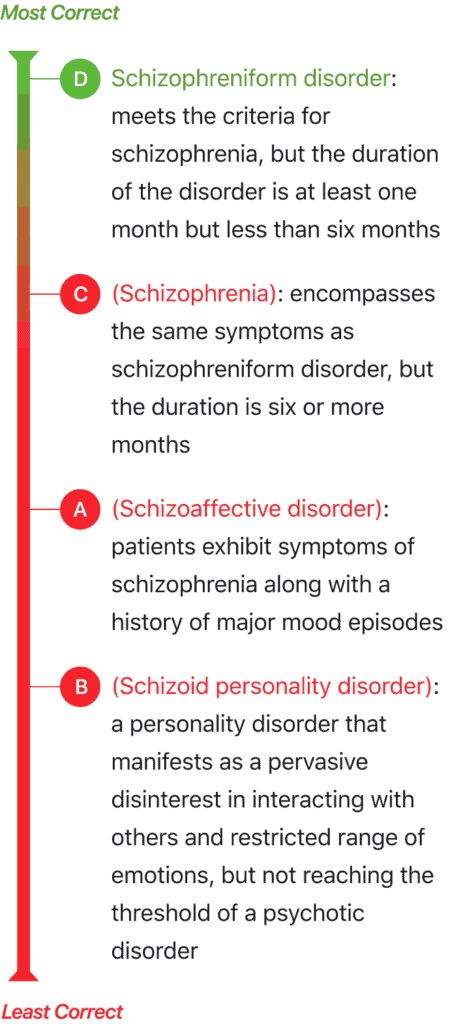
Once you understand the goal of the question writer to create answer choices that are supposed to discriminate knowledge, it is easier to exploit technical flaws and improve the odds of getting a question correct. The following three pointers round out our five tips that can help you answer a question correctly:
3. Look for answer choices containing absolute terms.
Absolute terms: terms such as “always” or “never.” When used in the answer options, these terms usually indicate an incorrect answer because they cannot hold up to scrutiny in all situations.
Which of the following characteristics of stealing is most consistent with a diagnosis of kleptomania?
A. Always occurs during mania
B. Lack of remorse for stealing
C. Never occurs during mania
D. Sense of relief after stealing
Contains absolute terms “always” and “never.” These should be avoided in answer choices because they are less likely to be true statements.
4. Keep an eye out for a long correct answer.
Long correct answer: the correct answer is longer, more specific, or more complete than the other options.
Fear of which of the following is a specifier of specific phobia?
A. Crowds
B. Natural environment, such as heights or storms
C. Open spaces
D. Public speaking
Option B is longer than the other options. The writers tend to pay more attention to the correct answer than to the distractors and write long correct answers that include additional instructional material, parenthetical information, and caveats.
5. Notice when a word repeats.
Word repeats: a word or phrase is included in the stem and in the correct answer.
A 58-year-old man with a history of major depression and post-traumatic stress disorder is hospitalized in the context of increased difficulty caring for himself. He speaks of experiencing the world as unreal. What is the term for this symptom?
A. Depersonalization
B. Derailment
C. Derealization
D. Focal memory deficit
This question uses the term “unreal” in the question stem, and “derealization” is the correct answer.
Whether you are taking your PRITE® or ABPN Psychiatry Board Exam, there is so much at stake. Taking the time to identify your unknown unknowns will not only help you prepare for and excel on your exam, it will help you expand your core knowledge. Then, on test day, use the five simple techniques to identify common flaws in questions, which will increase your chances of getting a question correct.
Give these methods a try and let me know how it goes. Moreover, I’d love to hear about techniques you use that I did not write about.
And if you’re looking for a psychiatry exam question bank, you know where to find one.
Best,
Thomas Xavier, MD




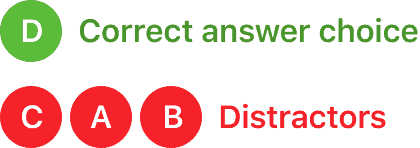

Comments (0)